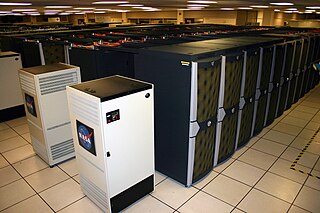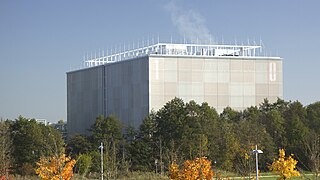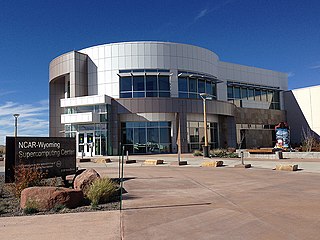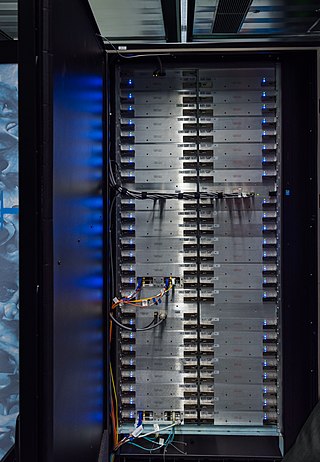
A supercomputer is a type of computer with a high level of performance as compared to a general-purpose computer. The performance of a supercomputer is commonly measured in floating-point operations per second (FLOPS) instead of million instructions per second (MIPS). Since 2017, supercomputers have existed which can perform over 1017 FLOPS (a hundred quadrillion FLOPS, 100 petaFLOPS or 100 PFLOPS). For comparison, a desktop computer has performance in the range of hundreds of gigaFLOPS (1011) to tens of teraFLOPS (1013). Since November 2017, all of the world's fastest 500 supercomputers run on Linux-based operating systems. Additional research is being conducted in the United States, the European Union, Taiwan, Japan, and China to build faster, more powerful and technologically superior exascale supercomputers.
Floating point operations per second is a measure of computer performance in computing, useful in fields of scientific computations that require floating-point calculations.

The National Energy Research Scientific Computing Center (NERSC), is high-performance computing (supercomputer) .National User Facility is operated by Lawrence Berkeley National Laboratory for the United States Department of Energy Office of Science. The mission is to establish a computing center for the Office of Science, NERSC houses high performance computing and data systems which can be used by 9,000 scientists at national laboratories and universities around the country. Research at NERSC is focused on fundamental and applied research with energy efficiency, storage, generation and Earth systems science, understanding of fundamental forces of nature and the Universe. The largest research areas are High Energy Physics, Materials Science, Chemical Sciences, Climate and Environmental Sciences, Nuclear Physics, and Fusion Energy research. NERSC's newest and largest supercomputer is Perlmutter, which debuted in 2021 and ranked 5th on the TOP500 list of world's fastest supercomputers.

The TOP500 project ranks and details the 500 most powerful non-distributed computer systems in the world. The project was started in 1993 and publishes an updated list of the supercomputers twice a year. The first of these updates always coincides with the International Supercomputing Conference in June, and the second is presented at the ACM/IEEE Supercomputing Conference in November. The project aims to provide a reliable basis for tracking and detecting trends in high-performance computing and bases rankings on HPL benchmarks, a portable implementation of the high-performance LINPACK benchmark written in Fortran for distributed-memory computers.
EKA, is a supercomputer built by the Computational Research Laboratories, a company founded by Dr. Narendra Karmarkar, for scaling up a supercomputer architecture he designed at the Tata Institute of Fundamental Research with a group of his students and project assistants over a period of 6 years.

JUGENE was a supercomputer built by IBM for Forschungszentrum Jülich in Germany. It was based on the Blue Gene/P and succeeded the JUBL based on an earlier design. It was at the introduction the second fastest computer in the world, and the month before its decommissioning in July 2012 it was still at the 25th position in the TOP500 list. The computer was owned by the "Jülich Supercomputing Centre" (JSC) and the Gauss Centre for Supercomputing.
The Green500 is a biannual ranking of supercomputers, from the TOP500 list of supercomputers, in terms of energy efficiency. The list measures performance per watt using the TOP500 measure of high performance LINPACK benchmarks at double-precision floating-point format.

Pleiades is a petascale supercomputer housed at the NASA Advanced Supercomputing (NAS) facility at NASA's Ames Research Center located at Moffett Field near Mountain View, California. It is maintained by NASA and partners Hewlett Packard Enterprise and Intel.

Tianhe-I, Tianhe-1, or TH-1 is a supercomputer capable of an Rmax of 2.5 peta FLOPS. Located at the National Supercomputing Center of Tianjin, China, it was the fastest computer in the world from October 2010 to June 2011 and was one of the few petascale supercomputers in the world.

The Leibniz Supercomputing Centre (LRZ) is a supercomputing centre on the Campus Garching near Munich, operated by the Bavarian Academy of Sciences and Humanities. Among other IT services, it provides supercomputer resources for research and access to the Munich Scientific Network (MWN); it is connected to the Deutsches Forschungsnetz with a 24 Gbit/s link.
Nebulae is a petascale supercomputer located at the National Supercomputing Center in Shenzhen, Guangdong, China. Built from a Dawning TC3600 Blade system with Intel Xeon X5650 processors and Nvidia Tesla C2050 GPUs, it has a peak performance of 1.271 petaflops using the LINPACK benchmark suite. Nebulae was ranked the second most powerful computer in the world in the June 2010 list of the fastest supercomputers according to TOP500. Nebulae has a theoretical peak performance of 2.9843 petaflops. This computer is used for multiple applications requiring advanced processing capabilities. It is ranked 10th among the June 2012 list of top500.org.
SAGA-220 is a supercomputer built by the Indian Space Research Organisation (ISRO).

Japan operates a number of centers for supercomputing which hold world records in speed, with the K computer being the world's fastest from June 2011 to June 2012, and Fugaku holding the lead from June 2020 until June 2022.

Several centers for supercomputing exist across Europe, and distributed access to them is coordinated by European initiatives to facilitate high-performance computing. One such initiative, the HPC Europa project, fits within the Distributed European Infrastructure for Supercomputing Applications (DEISA), which was formed in 2002 as a consortium of eleven supercomputing centers from seven European countries. Operating within the CORDIS framework, HPC Europa aims to provide access to supercomputers across Europe.
The Gauss Centre for Supercomputing (GCS) combines the three national supercomputing centres HLRS, JSC, and LRZ into Germany’s Tier-0 supercomputing institution. Each GCS member centre host supercomputers well beyond the 10 Petaflops performance mark. Concertedly, the three centres provide the largest and most powerful supercomputing infrastructure in all of Europe to serve a wide range of industrial and research activities in various disciplines. They also provide top-class training and education for the national as well as the European High Performance Computing (HPC) community.

Xeon Phi is a discontinued series of x86 manycore processors designed and made by Intel. It was intended for use in supercomputers, servers, and high-end workstations. Its architecture allowed use of standard programming languages and application programming interfaces (APIs) such as OpenMP.

Appro was a developer of supercomputing supporting High Performance Computing (HPC) markets focused on medium- to large-scale deployments. Appro was based in Milpitas, California with a computing center in Houston, Texas, and a manufacturing and support subsidiary in South Korea and Japan.

The NCAR-Wyoming Supercomputing Center (NWSC) is a high-performance computing (HPC) and data archival facility located in Cheyenne, Wyoming, that provides advanced computing services to researchers in the Earth system sciences.
The Cray XC30 is a massively parallel multiprocessor supercomputer manufactured by Cray. It consists of Intel Xeon processors, with optional Nvidia Tesla or Xeon Phi accelerators, connected together by Cray's proprietary "Aries" interconnect, stored in air-cooled or liquid-cooled cabinets. Each liquid-cooled cabinet can contain up to 48 blades, each with eight CPU sockets, and uses 90 kW of power. The XC series supercomputers are available with the Cray DataWarp applications I/O accelerator technology.

The Cray XC40 is a massively parallel multiprocessor supercomputer manufactured by Cray. It consists of Intel Haswell Xeon processors, with optional Nvidia Tesla or Intel Xeon Phi accelerators, connected together by Cray's proprietary "Aries" interconnect, stored in air-cooled or liquid-cooled cabinets. The XC series supercomputers are available with the Cray DataWarp applications I/O accelerator technology.














